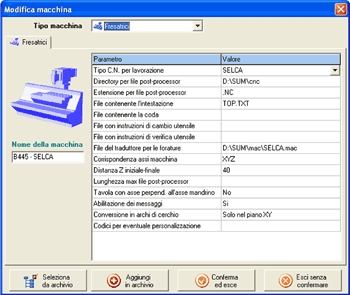SUM3D Features

SUM3D
3D CAM for CNC machines and robot
SUM3D performs functions that help users managing every part of the CAM processing. Being developped along decades and side by side with customers, SUM3D stands out for efficiency and effectiveness.
SUM3D allows the import of many file formats including: IGES, STEP, DXF, DWG, 3DM, PARASOLID, VDA, STL. Catia v4 and v5, Unigraphics, Step, Inventor, SAT, TopSolid. Pro|E importers are optionally available. All available interfaces are able to automatically recognize holes diameters allowing operators to speed up all machining operations.
In the same way it is possible to use pre-configured libraries within SUM3D; there is a library of tools and equipment that can be used within the work strategies, so as to be able to recall the geometries and technological data also from external tool catalogs and/or from self-produced archives. Furthermore, a vast library of postprocessors is already present in SUM3D, making it actually productive from the first day of use. SUM3D is equipped with pre-set libraries of tools and equipment so that users can easily retrieve machining geometry and data both from external and self-created archive. Moreover, SUM3D comes with a wide library of postprocessor included for a plug-and play solution.

The software offers the possibility of drawing the tool components (tool holders, spindles, extensions, etc.) allowing better toolpath calculation while improving the graphic simulation thanks to collision checks with the tool and working in highly safe environment.
Within SUM3D it is possible to configure your own archive of machine tools, including both milling machines and wire EDM machines. The machines can be set with all types of postprocessors at no additional cost. In this archive it is possible to customize the head, tail, tool change, wear check, fixed drilling cycles, the use of G2/G3 and the composition of the machine axes.
SUM3D supports several types of milling strategies for multiple machining operations such as: Machining on 2D objects (curves, holes, etc.) with contouring, flattening, emptying and residual material finishing strategies, including managing depth and lateral increases, oversizes and tool corrections. Machining on 3D objects (surfaces, solids, meshes, etc.) with advanced calculation options for the management of high-speed and technologically advanced machine. Some features like the variable pitch roughing and multiple finishing strategies with constant crest control, allow machine tools to get high level performance.
Every machining option can be applied to 4 and 5 axes machines, managing the tool orientation and positioning tool on the geometry to be machined.
SUM3D offers various simulation options both for the visualization of the residual material and the execution of shaving removal.
The kinematic simulation module allows the operator to verify the toolpath created directly in the 3D kinematics of the machine to simulate what should happen during machining process and plays a key role to guarantee maximum operation safety. The simulation options, offer clear representation of residual material areas that will be highlighted differently on base of the amount of the remaining material. The highlighted areas can be refined or used to generate a new blank for the machine. The simulation function is also extremely important to identify eventual collisions between the model and the toolpath.







